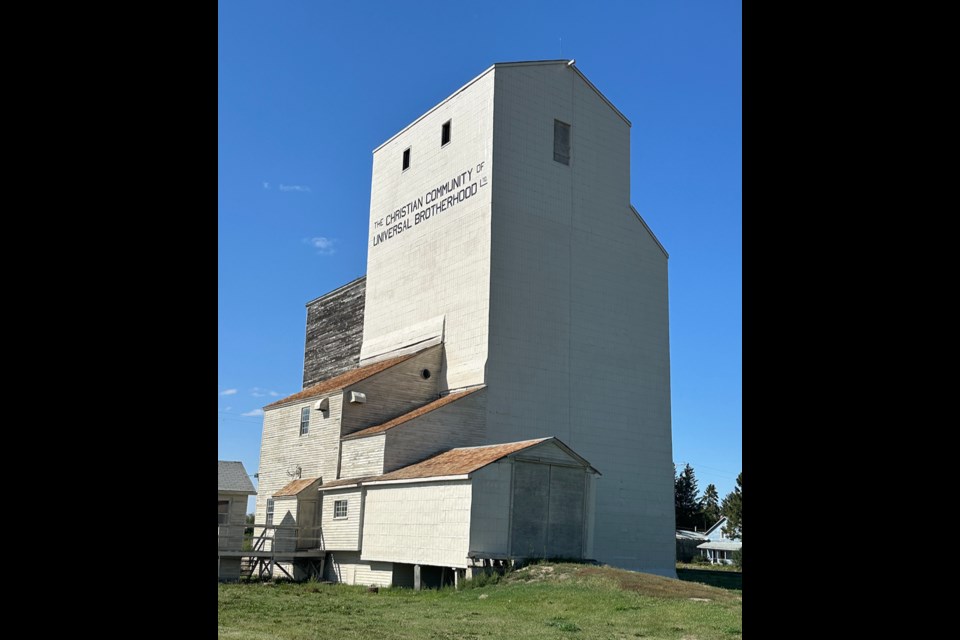VEREGIN - The first stage of restoration of the historic Doukhobor grain elevator at Veregin is now complete.
The restoration project, carried out this summer by the National Doukhobor Heritage Village, will preserve the structure as an icon of the district’s cultural and agricultural history.
Mast Construction, a High River, Alta. company specializing in grain elevator restoration, was commissioned by the museum to work on the 113-year old elevator. In mid-July, its construction crews arrived on site with materials, scaffolding and remote-controlled cranes with a reach of over 120 feet.
Over the course of a month, their efforts focused on preserving the character-defining exterior elements of the main elevator structure. A new cedar shake roof was installed. The original metal cladding, badly deteriorated or missing sections, was repaired, replaced and meticulously painted. Fittingly, the original company name, “The Christian Community of Universal Brotherhood Ltd.” was repainted on its north and south sides. The work was completed by the contractor in mid-August.
“We are very pleased with the quality and workmanship of the restoration,” said Andrew Kazakoff, a board member of the National Doukhobor Heritage Village and chair of its Elevator Restoration Committee. “This work will help ensure the elevator’s continued survival as a heritage structure,” he added.
According to Water Ostoforoff, another board member, “this stage of the elevator restoration project was made possible with the generous assistance of individual donations and grants.” Grant funding was received from the Saskatchewan Heritage Foundation, a crown agency that provides grants for heritage conservation projects, and from the CCUB Trust Fund, a provincial body established to disperse surplus funds that arose from the liquidation of assets of the Christian Community of Universal Brotherhood in 1938.
“We are very thankful to all contributors,” he added.
While the most critical work on the elevator has been completed, more remains to be done. This includes raising and levelling the driveway, replacing top windows, and restoring the exteriors of the elevator agent’s office and grain annex. However, both Kazakoff and Ostoforoff emphasize that this will require more funding.
“We have a little ways to go, but hopefully the progress we have already made will encourage more donations and support,” said Kazakoff.
“The plan is to have the total restoration completed over the next two or three years at an estimated cost of $80,000,” noted Ostoforoff.
Fortunately much of the elevator’s structure and interior, including its wood crib walls, concrete foundations, and machinery remain in good condition and do not require extensive (and expensive) refurbishment, despite not having been used for 40 years.
It is the goal of the museum to continue the restoration to the point where it can conduct historic tours of the structure to enable visitors to experience the workings of an elevator and understand how it was used to process grain.
Constructed in 1911 as a 60,000-bushel structure, it was one of several elevators built by the Christian Community of Universal Brotherhood to serve the grain-handling needs and communal economy of Doukhobor settlements across Western Canada. For 24 years, it received, stored and shipped grain communally grown by the Doukhobors of Veregin and district as well as that of their neighbours.
In 1935, it was sold to Federal Grain Limited, which ran it until 1972. In 1960, the company added a 60,000-bushel storage annex on the west side. When Federal was sold to the Saskatchewan Wheat Pool in 1972, it continued to operate as the Pool’s “B” elevator at Veregin. In 1986, it was sold to Pioneer Grain Company, then bought again by Saskatchewan Wheat Pool in 1996 and permanently closed in 1997.
In 2001, the elevator was acquired by the National Doukhobor Heritage Village and now forms part of a 12.6 acre complex of museum buildings adjacent to the CN railway in Veregin in the Rural Municipality of Sliding Hills. In July 2009, it was designated a National Historic Site by Parks Canada. In August 2018, it was designated a Saskatchewan Provincial Heritage Property by the Government of Saskatchewan.
Now one of the oldest grain elevators in Saskatchewan still standing in its original location, it is a reminder of the ‘sentinels of the prairies’ that once numbered in the thousands, and were the most prominent architectural symbol of the Canadian Prairies in the twentieth century. Its restoration helps preserve this legacy.
The heritage restoration value of the elevator at Veregin also lies in its form. It is distinguished by its unique roof design. It is neither the pyramidal roof with pyramidal-roofed cupola, nor gable roof with gable-roofed cupola, design of elevators built during its era. Instead it has a wide gable-roofed cupola, without additional roof structure, that is an extension of the elevator structure itself.
Finally, the importance of the restoration lies in the elevator’s cultural association with its builders, the Doukhobors. In 1899, 7,500 Doukhobors emigrated from Russia to Canada seeking religious freedom. Persecuted in Tsarist Russia for their pacifist beliefs, they came to Saskatchewan, establishing numerous communal settlements, including one at Veregin. Working together under the motto of “Toil and Peaceful Life” they transformed prairie wilderness into productive farmland, established rural infrastructure improvements and played an important role in the agricultural development of the province.
Individuals wishing to donate to the historic Doukhobor grain elevator may contact the National Doukhobor Heritage Village by phone at (306)-542-4441) or by email at [email protected]. Charitable tax receipts are available.
Don't count on social media to deliver your local news to you. Keep your news a touch away by bookmarking Canora Courier's homepage at this link.
Bookmark SASKTODAY.ca, Saskatchewan's home page, at this link.




